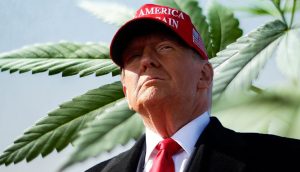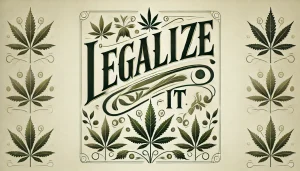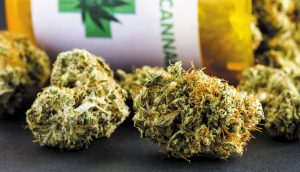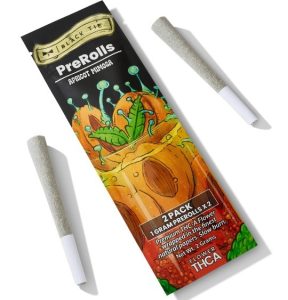Traditional Medicine Part 5: Two Indigenous Canadian Court Challenges About Cannabis
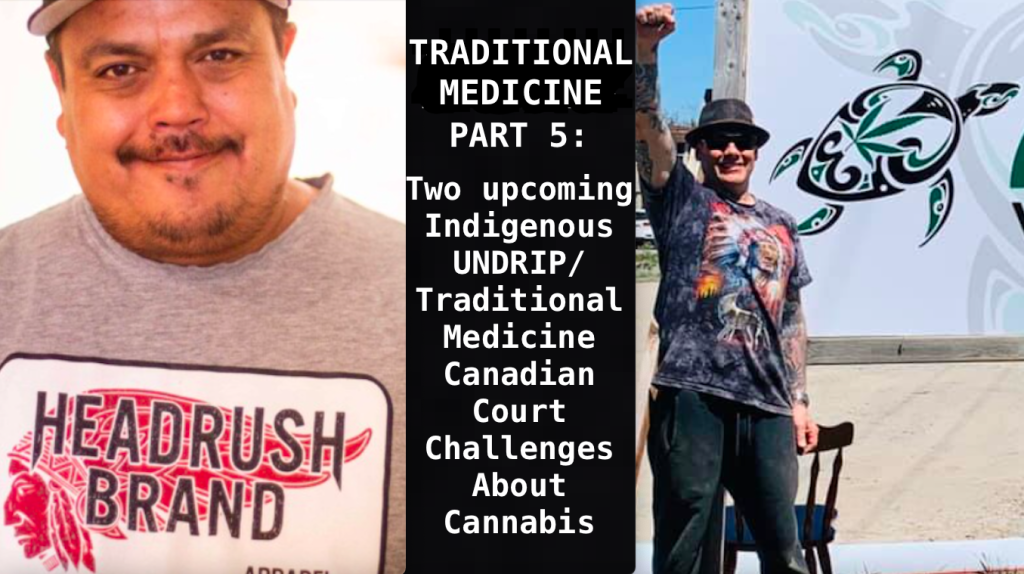
The next instalment in Cannabis Culture’s ongoing series regarding the applicability of UNDRIP “traditional medicine” rights of Indigenous people to the use and the economies of psychoactive and psychedelic plant drugs.
Part 1 was all about cannabis.
Part 2 looked closer at the United Nations UNDRIP treaty and at the concept of Biopiracy.
Part 3 looked at ayahuasca.
Part 4 looked at blue lotus and red lotus.
In part 5, we take a look into two ongoing court cases in Canadian court regarding the use of UNDRIP “traditional medicine” rights as they relate to Indigenous people selling cannabis.
Indigenous peoples have the right to their traditional medicines and to maintain their health practices, including the conservation of their vital medicinal plants, animals and minerals.”
– UNDRIP, Article 24, part 1 (1)
Case #1
I recently bumped into lawyer Rob Laurie at a psychedelic drug forum. We had known each other earlier from various cannabis activist events, and I was happy to learn he had become involved in Cory Brewer’s defense of his “Tupa’s Joint” Indigenous-run dispensary in Vernon, B.C., that was raided by the British Columbia “Community Safety Unit” (CSU) back in 2020 (see Traditional Medicine, part 1).
I mentioned to Rob that I had written an article about Indigenous people of the Americas and their use of cannabis and how that relates to the UNDRIP “traditional medicine” rights, and I told him I would send him the link. He returned the favour by sharing with me the initial response from the BC CSU, to ask me what I thought of it. The following was my response to him:
Dear Rob,
After having re-read the BC Community Safety Unit decision of April 6th, 2023 in the case of Cory Brewer/’Tupa’s Joint’, I have come to the conclusion that the entire decision revolves around this quote here:
“The exercise of the rights set forth in this [UN] Declaration shall be subject only to such limitations as are determined by law and in accordance with international human rights obligations. Any such limitations shall be non-discriminatory and strictly necessary solely for the purpose of securing due recognition and respect for the rights and freedoms of others and for meeting the just and most compelling requirements of a democratic society.”
– Taken from Section 46:2. of UNDRIP, quoted in paragraph 73 on page 19 of the CSU’s decision.
Is the CSU making the claim that the Cannabis Control and Licensing Act of British Columbia and the Cannabis Act of Canada are more necessary for being “in accordance with international human rights obligations” and necessary for “due recognition and respect for the rights and freedoms of others and for meeting the just and most compelling requirements of a democratic society” than UNDRIP is?
Seems to me that – on the surface – taking away Indigenous people’s medicines and charging them with criminal offences for distributing such medicines is not only a violation of the international human rights in UNDRIP, but also in the genocide treaty, the Universal Declaration of Human Rights 1948 (specifically the ‘dignity’ section), the UN anti-slavery treaty of 1959 (they made me work in the pallet factory at the Frasier Regional Correctional Center for pennies per day for my herb-related crimes) and the 1966 UN treaty on economic, social and cultural rights – the freedom to not be exploited.
It seems that the weakness of the argument is in the words “most compelling” – because for me, it’s more compelling that the governments of Canada and British Columbia respect the rights involving traditional medicine found in UNDRIP (and all those other rights I just mentioned) than it is to respect either
a) the regulations of the CCLA or the Cannabis Act, which are either arbitrary or irrational or hypocritical:
b) the Canadian Charter of Rights and Freedoms (with respect to cannabis) – which is on the surface problematic:
Seems to me that if it’s a matter of determining which set of rules is most ‘compelling’ – the task before us is to – in a very public way – compare ‘traditional medicine’ rights under UNDRIP (outlining where they are located in UNDRIP, what the definition of ‘tradition’ and ‘medicine’ is, and then exploring the history of Indigenous use of cannabis) and then comparing all that with a) the contradictions in Canadian/BC cannabis legislation (how it didn’t bring about greater quality, it didn’t remove organized crime, it didn’t protect young people from harm) and b) problems in Canadian constitutional cannabis law (the ‘cannibal argument’ & all the times the harm principle was found in key legal documents yet ignored by the Supreme Court who pretended it wasn’t a ‘principle of fundamental justice’) found in the two links that I supplied above in a) and b).
That’s my understanding. Is that your understanding too? Did I miss something?
Do I have your permission to turn this conversation into an article for Cannabis Culture?
Sincerely,
David (2)
Rob gave me permission to publish my reaction to his information (as long as he had a chance to check out the rough copy first of the article first) and gave me another piece of the puzzle: In November 2019, the Government of British Columbia has by itself ratified UNDRIP on a provincial level – with “DRIPA” – the Declaration on the Rights of Indigenous Peoples Act. (3)
One of the four “main themes” of the act involves the right to control “lands and resources”:
Title and Rights of Indigenous Peoples: Indigenous Peoples exercise and have full enjoyment of their inherent rights, including the rights of First Nations to own, use, develop and control lands and resources within their territories in B.C. (4)
And here’s the kicker – DRIPA actually mentions cannabis explicitly:
Advance a collaborative approach to cannabis-related governance and jurisdiction between First Nations and the Province that reflects common objectives to protect youth, prioritize public health and safety, strengthen First Nations governance capacity and secure economic benefits for First Nations. (Ministry of Public Safety and Solicitor General) (5)
The BC Assembly of First Nations have taken notice of this, and are getting involved in shaping DRIPA’s impact on BC Indigenous cannabis retailers:
BCAFN is currently undertaking work in partnership with the UBCIC (Union of British Columbia Indian Chiefs) and FNS (First Nations Summit) to establish the appropriate Non-medical Cannabis Legalization and Regulation structures and ensure capacity funding in order to move work under the BC First Nations Cannabis Strategy Framework and DRIPA Action Plan forward. Based on in-principle support of the Strategy Framework, BCAFN will also work to support finalization of the Strategy itself and will report back to the Chiefs-in-Assembly regularly. (6)
It remains to be seen if the BCAFN (and/or the courts) end up supporting an inclusive or exclusive cannabis regulatory model, but it’s clear that UNDRIP and DRIPA are both playing a key role in this discussion.
 Image taken from the Facebook page of the North Shore Anishinabek Cannabis Association May 22, 2020. I don’t know if they are involved in the legal argument in Case #2 but according to their website they are from the “North Shore of Lake Huron” so they very well may be involved in Case #3. Plus the photo was badass.
Image taken from the Facebook page of the North Shore Anishinabek Cannabis Association May 22, 2020. I don’t know if they are involved in the legal argument in Case #2 but according to their website they are from the “North Shore of Lake Huron” so they very well may be involved in Case #3. Plus the photo was badass.
Case #2
The second case involves lawyer Jack Lloyd and a collection of Indigenous cannabis retailers in Ontario. Mr. Lloyd was too busy to let me know what was going on, but he kindly provided lawyer Kirk Tousaw to fill me in on some of the details. The following was an email Kirk provided me:
Hey David:
Litigation ongoing in ON that deals with whether or not indigenous people have a right to trade in cannabis per s. 35 of the Charter.
The question is whether the test of whether a pre-treaty right exists is influenced by UNDRIP. In Quebec the Court said yes, in the tobacco context. It is not yet determined in ON or BC. Jack’s case is in trial right now but slightly different context dealing with a previously unrecognized band, so the UNDRIP issues are not directly engaged as yet. Bunch of stuff in the system in various provinces.
Kirk (7)

Jack Lloyd (left) and Kirk Tousaw.
Regarding section 35 of the Canadian Charter of Rights and Freedoms, it turns out it’s all about “Aboriginal Rights” – Indigenous Rights using 1982 terminology:
Rights of the Aboriginal Peoples of Canada
Recognition of existing aboriginal and treaty rights
35 (1) The existing aboriginal and treaty rights of the aboriginal peoples of Canada are hereby recognized and affirmed.
Definition of aboriginal peoples of Canada
(2) In this Act, aboriginal peoples of Canada includes the Indian, Inuit and Métis peoples of Canada.
Land claims agreements
(3) For greater certainty, in subsection (1) treaty rights includes rights that now exist by way of land claims agreements or may be so acquired.
Aboriginal and treaty rights are guaranteed equally to both sexes
(4) Notwithstanding any other provision of this Act, the aboriginal and treaty rights referred to in subsection (1) are guaranteed equally to male and female persons.
Commitment to participation in constitutional conference
35.1 The government of Canada and the provincial governments are committed to the principle that, before any amendment is made to Class 24 of section 91 of the Constitution Act, 1867, to section 25 of this Act or to this Part,
(a) a constitutional conference that includes in its agenda an item relating to the proposed amendment, composed of the Prime Minister of Canada and the first ministers of the provinces, will be convened by the Prime Minister of Canada; and
(b) the Prime Minister of Canada will invite representatives of the aboriginal peoples of Canada to participate in the discussions on that item. (8)
When I searched for “Quebec UNDRIP tobacco” I found out about a November 1st, 2023 ruling on how UNDRIP guaranteed the right of Indigenous Canadians to sell tobacco – according to at least one Quebec judge. (9) The ruling was appealed by the Quebec government in January of 2024. The CBC covered the story about the appeal on January 11th:
Quebec is appealing a ruling last year that stayed proceedings on charges related to tobacco trade against two Kanien’kehá:ka (Mohawk) men, citing treaty rights. The Attorney General of Quebec and director of criminal and penal prosecutions filed a notice of appeal in December regarding a Quebec Superior Court judge’s decision to stay proceedings against Derek White and Hunter Montour, both from Kahnawà:ke, south of Montreal, for importing untaxed tobacco. According to the appeal, Justice Sophie Bourque ‘erred in principle, in law and in fact’ in her nearly 400-page decision in November that has been described as a ‘landmark’ ruling.
In 2019, a jury acquitted White on charges of defrauding Quebec of $44 million in tobacco taxes but found the two guilty on federal charges for not paying excise tax on tobacco products. The pair had asked for a stay of proceedings, arguing that the government had violated their Section 35 Constitutional rights, as well as the United Nations Declaration on the Rights of Indigenous Peoples (UNDRIP), and their inherent rights as Kanien’kehá:ka to trade tobacco tax-free. The appellants dispute Bourque’s declaration that section 42 of the Excise Act constitutes an unjustified infringement of Montour and White’s Aboriginal and treaty rights, and the order staying the criminal proceedings, among other aspects of her ruling.
The appeal argues that the judge erred in law and in fact in concluding that the Covenant Chain — a series of agreements starting in the 1700s between the Haudenosaunee Confederacy and British colonies that included the right to trade — is an unextinguished treaty of peace and friendship and that it includes a conflict resolution procedure. It argues that she also erred in law in her interpretation of the UNDRIP and made errors of fact in assessing the credibility of certain expert witnesses. In an emailed statement, a representative of Quebec’s ministry of Justice said it will not comment on the case out of respect for the legal process. However, the appeal doesn’t come as a surprise from those involved with the case.
‘It was always going to happen, and we all assumed that from the beginning,’ said Nathan Richards, one of four lawyers on the case representing White and Montour. ‘The judge would make remarks from time to time that ‘no matter what I decide, it’s going to be appealed.’ And she was right about that.’ Richards said the appeal process is expected to be long, and believes the case could end up before the Supreme Court of Canada.
Gerald Taiaiake Alfred, a Kanien’kehá:ka scholar from Kahnawà:ke who testified for the defence as an expert witness on Indigenous governance and the community’s politics, said of the appeal, ‘What they’re asking for is for us to keep our minds within the Canadian legal framework and to operate in the parameters of legal precedents that have been set by white reasoning and to not bring in Native understandings of law and to exclude Native understandings of law, to disregard First Nations knowledge of what our past was and what our treaties are and what they mean.’
Regardless of the outcome, Alfred said the case still has significant impacts. ‘I think the significant impact is in Kahnawà:ke, in validating the perspective that we have,’ he said. ‘I can’t see other communities right now disregarding that. But I also think that because of the appeal, it’s not having the ripple effect that other people would anticipate having and know that’s going to have to wait for the appeal.’ (10)
Back in October of 2021, Jack Lloyd had this to say about Indigenous cannabis retail rights:
As for the legality of Medicine Wheel, lawyer Jack Lloyd told the Star that, in general, Hughes could argue that there is a history of Indigenous trade and medical use of the cannabis plant prior to colonialism. Lloyd, who represents Hughes, said there is a difference between the sovereignty that Hughes is expressing and the ‘sovereign citizen’ movement. ‘Sovereign citizens’ have traditionally been people who strive to sever ties with the government, ‘de-registered’ themselves from drivers licences, health cards, and have often supported unobstructed property rights. Unlike those that identify as ‘sovereign citizens,’ Lloyd says that Hughes’ situation is a ‘distinct issue’ related to Indigenous rights to various substances, noting that cannabis is similar to tobacco in its traditional use by Indigenous peoples. (11)
It remains to be seen if the courts of Ontario see cannabis as similar to tobacco with respects to UNDRIP rights – or even if the higher courts uphold the findings of the lower courts in terms of tobacco. This author has had personal experience with the irrationality expressed in the decision arising from his own Supreme Court of Canada constitutional challenge (R. v. Malmo-Levine 2003), and wonders if the “legalization” (cartelization) of cannabis by the Canadian government is an opportunity for further inclusivity, or a stop-gap measure to prevent further inclusivity.
Summary
The legal landscape of cannabis in Canada has transformed, and so too has Canadian cannabis activism. Cannabis activism in Canada has transformed itself from anti-prohibitionists arguing in court (and in the media) that the prohibition of cannabis is unconstitutional into legacy retailers – especially Indigenous retailers – arguing in court (and in the media) that the Canadian Cannabis Act is too limiting, and has left out those who cannot overcome the economic and legal hurdles created by the Cannabis Act. As David Hurford – secretary of the BC Craft Farmers Co-op – recently pointed out:
‘But the risk and price tag associated with applying for the licence are immense, and growers can’t make a return with such a small footprint, Hurford said. Anselmo agreed, noting it can cost $500,000 to $1 million with no guarantee of approval. ‘It’s a lot of upfront risk,’ he said.’ (12)
Albert Eppinga, owner of BC Cannabis Inc., explained why there were so few Indigenous-owned LPs, in spite of the BC First Nations people having a long history of participating in the legacy market:
It takes a lot of money, it takes a lot of energy and time and regulations, security clearances, all of that . . . And a lot of First Nations people, they don’t really have good security clearances, the guys who want to do it. Many of us come from the black, or grey, or legacy market or whatever you want to call it. It’s changed so much over time. But a lot of my colleagues and friends, we’ve been growing for decades so we know what we are doing. We have over a hundred years of experience on our team. But getting the money, and being able to pass a security clearance, or having the confidence to navigate the regulations, it’s hard for many. (13)
UNDRIP is one of the main weapons used by Indigenous peoples to fight for their right to be included in the cannabis economy. It appears that UNDRIP is going to be a key component of two upcoming Indigenous cannabis cases, and has been found a key component in a Quebec tobacco case, which the government of Quebec is currently appealing.
The key questions in both cases seems to me to be:
What’s more important: 1) enforcing the strict limitations to inclusion in the cannabis economy based on Reefer Madness 2.0, or 2) upholding the rights to ‘Traditional Medicine’ found in UNDRIP?
This author had guessed back in June of 2022 that UNDRIP would be an important element of cannabis activism going forward. These two court cases now winding their way through the Canadian court system have proven me right. I am in contact with both legal teams and will report to the readers any future developments in these cases within this ongoing series on Indigenous traditional medicines here at Cannabis Culture.
Post Script – Case #3
After Rob Laurie had a chance to look at this article, he called me and let me know of one other court case that might have an effect on these two cases: The Amikwa case. The Amikwa people – also known as the Beaver People – was a tribe who had “inhabited the north shore of Lake Huron, opposite the island of Manitoulin, along the shores between Missisagi and French Rivers, and along Spanish River” and “were nearly wiped out by disease and wars with the Iroquois and the last of the tribe appear to have merged with the Nipissings or the Ojibwe.” (14)
The 10 defendants in the Amikwa case say they can trace their genealogy back to the Amikwa, who never signed any treaties with Canada, and thus are outside of Canada’s legal jurisdiction:
Amikwa lacks recognition from the federal government and neighbouring First Nations. However, Chief Stacy Amikwabi is actively working on community rebuilding through historical research and advocacy. Since the Amikwa never entered a treaty or relinquished their territory, Mr. Swinwood contends that cannabis laws don’t apply to its members. They assert their traditional right to engage in the use and trade of cannabis and hemp. (15)
While UNDRIP hasn’t been mentioned in media coverage of the trial, one of the experts that the Amikwa defendants plan to call – Professor Konstantia Koutouki – has written about UNDRIP in relation to cannabis. The following is the conclusion to her 2019 article she co-authored in the Alberta Law Review, titled CANNABIS, RECONCILIATION, AND THE RIGHTS OF INDIGENOUS PEOPLES: PROSPECTS AND CHALLENGES FOR CANNABIS LEGALIZATION IN CANADA:
The development of a new framework for cannabis legalization in Canada holds tremendous potential as a step towards reconfiguring the relationships between First Nations, Métis, and Inuit peoples and Canadian legal and governmental institutions. In addition to the chance to redress past harms, such as the disproportionate impact of cannabis prohibition on Indigenous peoples in Canada, legalization is an opportunity for Indigenous communities to begin implementing their own economic and justice systems in a meaningful way. It is also an opportunity for Canada to implement the TRC’s Calls to Action, as well as its commitment to adopt UNDRIP as a framework for reconciliation.
Unfortunately, the new legislation, as it currently stands, fails to seize these opportunities. It is inadequate both in terms of the lack of consultation with Indigenous communities, as well as in terms of the substantive provisions — and omissions — in the legislation itself. It is also important to keep in mind that Canada’s obligations — both moral and legal — extend beyond national borders.
Canada has been a participant in the ‘globalization of drug production and consumption,’ as well as a key player in international drug prohibitions that have caused untold suffering around the world. Now, with cannabis legalization, many Canadian producers are poised to reap tremendous financial rewards from this newly licit industry, while the federal and provincial governments will benefit from the tax revenue. Yet many of the strains at the heart of this cannabis boom have been developed from landraces cultivated for generations by Indigenous and local communities around the world — communities that have not been able to exercise their right to free, prior, and informed consent, and have not been compensated for their genetic resources and associated traditional knowledge.
All in all, the legalization of cannabis is an important first step towards redressing past harms, and presents Indigenous communities in Canada with new opportunities for greater political, economic, and cultural self-determination in the future. But if not handled carefully, and without the participation of Indigenous peoples as equal partners, legalization risks perpetuating injustices both in Canada and abroad. (16)
Citations
1) United Nations Declaration on the Rights of Indigenous Peoples, Resolution adopted by
the General Assembly on 13 September 2007
https://www.un.org/esa/socdev/unpfii/documents/DRIPS_en.pdf
2) Personal correspondence with the author, December 30 th , 2023
3) “The Declaration on the Rights of Indigenous Peoples Act (Declaration Act) passed unanimously in the B.C. legislature on November 26, 2019, and came into force on November 29, 2019. B.C. is the first jurisdiction in Canada to have passed legislation to formally adopt the internationally recognized standards of the United Nations Declaration on the Rights of Indigenous Peoples (UN Declaration). The Declaration Act mandates government to bring provincial laws into alignment with the UN Declaration and to develop and implement an action plan to achieve the objectives of the UN Declaration in consultation and co-operation with Indigenous Peoples. Through this work, B.C. is building a province where Indigenous Peoples’ excellence, leadership, governance, and self-determination is recognized and respected.”
See also: https://www2.gov.bc.ca/gov/content/governments/indigenous-people/new-
relationship/united-nations-declaration-on-the-rights-of-indigenous-peoples
4) https://www2.gov.bc.ca/gov/content/governments/indigenous-people/new-relationship/united-nations-declaration-on-the-rights-of-indigenous-peoples/implementation
5) https://www2.gov.bc.ca/assets/gov/government/ministries-organizations/ministries/indigenous-relations-reconciliation/declaration_act_action_plan.pdf
6) https://www.bcafn.ca/sites/default/files/docs/reports-presentations/BCAFN%20Newsletter%20SS2022_EV.pdf
7) Personal correspondence with the author, January 29 th , 2024
8) https://laws-lois.justice.gc.ca/eng/const/page-13.html#docCont
9) https://coursuperieureduquebec.ca/fileadmin/cour-superieure/Jugements_diffuses_sur_X/R._c._White_et_Montour.pdf
10) “Quebec appeals ‘landmark’ decision recognizing Kanien’kehá:ka treaty right to trade tobacco Disputes judge’s ruling that Excise Act is an unjustified infringement on treaty rights” Ka’nhehsí:io Deer · CBC News · Posted: Jan 11, 2024
https://www.cbc.ca/news/indigenous/quebec-appeals-treaty-right-tobacco-trade-1.7080655
11) “Indigenous-owned cannabis shop aims to fight ‘economic genocide’ and is operating
without provincial licensing” October 1, 2021
https://www.thestar.com/news/gta/toronto-s-first-sovereign-indigenous-owned-cannabis-shop-aims-to-fight-economic-genocide-and-is/article_cb3b1011-ab1e-5e65-ac73-f1f8a3e540c8.html
12) “’Hype, hope and dreams’: B.C.’s craft cannabis industry stunted,” Jan. 31, 2022
https://bc.ctvnews.ca/hype-hope-and-dreams-b-c-s-craft-cannabis-industry-stunted-1.5761132
13) “BC Cannabis Inc on the micro model serving First Nations in BC,” May 8, 2021
BC Cannabis Inc on the micro model serving First Nations in BC
14) https://en.wikipedia.org/wiki/Amikwa_people
15) https://www.pentictonherald.ca/spare_news/article_6a53b1d5-1c87-5af4-8fe1-3b141507825b.html
16) Konstantia Koutouki and Katherine Lofts, Cannabis, Reconciliation, and the Rights of Indigenous Peoples: Prospects and Challenges for Cannabis Legalization in Canada, 2019
56-3 Alberta Law Review 709, 2019 CanLIIDocs 356
https://canlii.ca/t/sfcs











